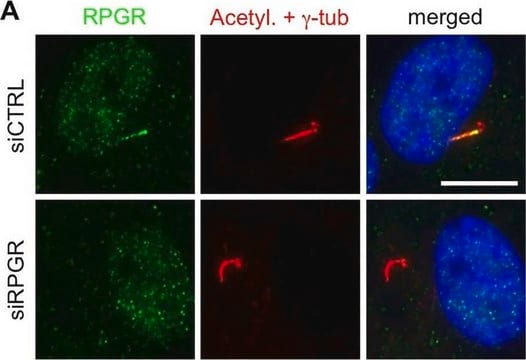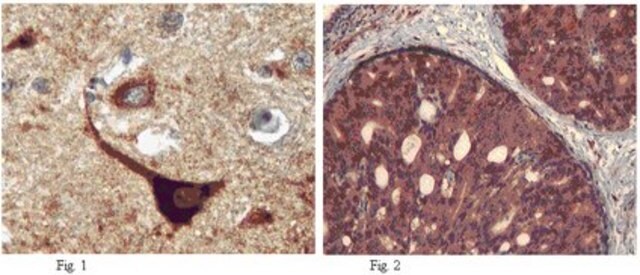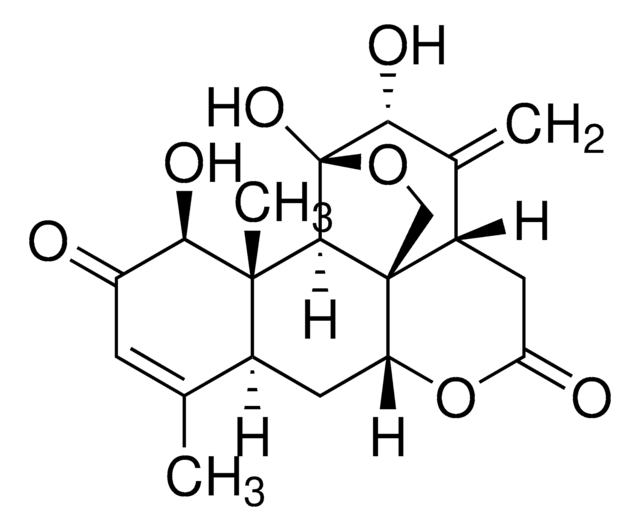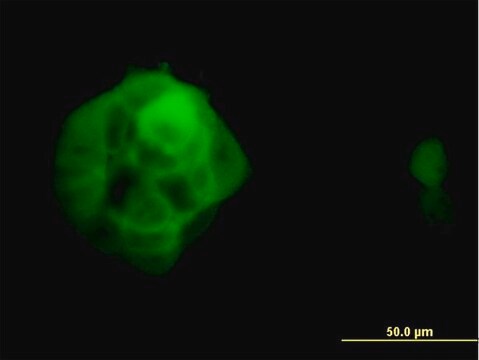This antibody has not been tested in zebrafish. No unpublished data is available.
ABN1686
Anti-Rootletin
from chicken, purified by affinity chromatography
Sinónimos:
Ciliary rootlet coiled-coil protein
Seleccione un Tamaño
$414.00
Fecha estimada de envío26 de mayo de 2025
Seleccione un Tamaño
About This Item
$414.00
Fecha estimada de envío26 de mayo de 2025
Productos recomendados
origen biológico
chicken
Nivel de calidad
forma del anticuerpo
affinity isolated antibody
tipo de anticuerpo
primary antibodies
clon
polyclonal
purificado por
affinity chromatography
reactividad de especies
human, porcine, mouse
técnicas
western blot: suitable
isotipo
IgY
Nº de acceso NCBI
Nº de acceso UniProt
Condiciones de envío
ambient
modificación del objetivo postraduccional
unmodified
Información sobre el gen
mouse ... Crocc(230872)
Descripción general
Especificidad
Inmunógeno
Aplicación
Neuroscience
Immunohistochemistry Analysis: A representative lot detected Rootletin in Immunohistochemistry applications (Yang, J., et. al. (2002). J Cell Biol. 159(3):431-40; Sun, X., etl al. (2016). Proc Natl Acad Sci USA. 113(21):E2925-34; Yadav, S.P., et. al. (2016). Development. 143(9):1491-501; Pawlyk, B.S., et. al. (2016). Gene Ther. 23(2):196-204; Sun X., et. al. (2012). Cilia. 1(1):21; Liu, X., et. al. (2007). Proc Antl Acad Sci USA. 104(11):4413-8; Bahe, S., et. al. (2005). J Cell Biol. 171(1):27-33; Yang, J., et. al. (2005). Mol Cell Biol. 25(10):4129-37; Hong, D.H, et. al. (2003). Invest Ophthalmol Vis Sci. 44(6):2413-21).
Calidad
Western Blotting Analysis: A 1,000 dilution of this antibody detected Rootletin in 10 µg of mouse retina tissue lysate.
Descripción de destino
Forma física
Almacenamiento y estabilidad
Handling Recommendations: Upon receipt and prior to removing the cap, centrifuge the vial and gently mix the solution. Aliquot into microcentrifuge tubes and store at -20°C. Avoid repeated freeze/thaw cycles, which may damage IgG and affect product performance.
Otras notas
Cláusula de descargo de responsabilidad
¿No encuentra el producto adecuado?
Pruebe nuestro Herramienta de selección de productos.
Código de clase de almacenamiento
10 - Combustible liquids
Clase de riesgo para el agua (WGK)
WGK 2
Certificados de análisis (COA)
Busque Certificados de análisis (COA) introduciendo el número de lote del producto. Los números de lote se encuentran en la etiqueta del producto después de las palabras «Lot» o «Batch»
¿Ya tiene este producto?
Encuentre la documentación para los productos que ha comprado recientemente en la Biblioteca de documentos.
-
Has ABN1686 been tested on zebrafish? Do you have any unpublished data?"
1 answer-
Helpful?
-
Active Filters
Nuestro equipo de científicos tiene experiencia en todas las áreas de investigación: Ciencias de la vida, Ciencia de los materiales, Síntesis química, Cromatografía, Analítica y muchas otras.
Póngase en contacto con el Servicio técnico








